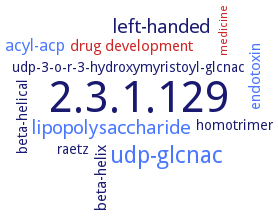2.3.1.129: acyl-[acyl-carrier-protein]-UDP-N-acetylglucosamine O-acyltransferase
This is an abbreviated version!
For detailed information about acyl-[acyl-carrier-protein]-UDP-N-acetylglucosamine O-acyltransferase, go to the full flat file.

Word Map on EC 2.3.1.129 
-
2.3.1.129
-
udp-glcnac
-
lipopolysaccharide
-
left-handed
-
acyl-acp
-
endotoxin
-
drug development
-
beta-helix
-
beta-helical
-
homotrimer
-
udp-3-o-r-3-hydroxymyristoyl-glcnac
-
raetz
-
medicine
- 2.3.1.129
- udp-glcnac
- lipopolysaccharide
-
left-handed
- acyl-acp
- endotoxin
- drug development
-
beta-helix
-
beta-helical
-
homotrimer
-
udp-3-o-r-3-hydroxymyristoyl-glcnac
-
raetz
- medicine
Reaction
Synonyms
acyltransferase, uridine diphosphoacetylglucosamine, LiLpxA, LpxA, type II ACP-dependent UDP-N-acetylglucosamine acyltransferase, type II acyl carrier protein-dependent UDP-N-acetylglucosamine acyltransferase, UDP-N-acetylglucosamine 3-O-acyltransferase, UDP-N-acetylglucosamine acyltransferase, uridine diphosphoacetylglucosamine acyltransferase
ECTree
Advanced search results
Inhibitors
Inhibitors on EC 2.3.1.129 - acyl-[acyl-carrier-protein]-UDP-N-acetylglucosamine O-acyltransferase
Please wait a moment until all data is loaded. This message will disappear when all data is loaded.
(3aR,10aR,13aR,20aR)-2,12-dimethyldecahydro-1H,10aH-[1,4,7,10,13,16]hexaoxacyclooctadecino[11,12-c:2,3-c']dipyrrole-1,3,11,13(2H,12H,13aH)-tetrone
compound identified using a complex-based pharmacophore model. Compound shows selective inhibition properties with essential residues in the pocket. The compound complies with the Lipinski rule showing no toxicity and drug likeness properties
(3Z,5Z,7S,8S,9S,11Z,13E,15S,16S)-16-[(2R,3S,4R,6E,8S,9S)-3,9-dihydroxy-4,8-dimethyl-5-oxodec-6-en-2-yl]-8-hydroxy-3,15-dimethoxy-5,7,9,11-tetramethyl-1-oxacyclohexadeca-3,5,11,13-tetraen-2-one
compound identified using a complex-based pharmacophore model. Compound shows selective inhibition properties with essential residues in the pocket. The compound complies with the Lipinski rule showing no toxicity and drug likeness properties
1-benzoyl-2-(1H-indol-3-ylmethyl)-4-(2-oxo-2-(1-pyrrolidinyl)ethyl)-3-piperidinol
binding energy score of 4.01. In docked pose, the pyrrolidine ring of the molecule is positioned along H120 of chain A and the indole ring is placed towards chain E. It forms hydrogen bonds with H120 (NE atom) and Q156 (OE1 atom), G139 (N backbone) from chain A and G150 (N backbone) of chain E
2-[[2-[(benzenesulfonyl)oxy]ethyl](phenyl)amino]ethyl 4-methylbenzene-1-sulfonate
compound identified using a complex-based pharmacophore model. Compound shows selective inhibition properties with essential residues in the pocket. The compound complies with the Lipinski rule showing no toxicity and drug likeness properties
3-((3-(((3,4-dichlorophenoxy)acetyl)amino)-15-pyridin-1-yl)methyl)benzenesulfonyl fluoride
binding energy score of 4.4. The dichlorophenoxy-acetyl-amino group occupies a position similar to that of the uridine moiety of the nucleotide substrate. The chlorine atom forms hydrophobic interactions with I147, M165 and V129 of chain E whereas the sulfur group forms pi-sulfur interaction with H120 of chain A
5-amino-4-hydroxy-3-[(E)-[8-hydroxy-6-(hydroxysulfonothioyl)-3-sulfonaphthalen-1-yl]diazenyl]naphthalene-2,7-disulfonic acid
compound identified using a complex-based pharmacophore model. Compound shows selective inhibition properties with essential residues in the pocket. The compound complies with the Lipinski rule showing no toxicity and drug likeness properties
7-[3-([(2S)-2-hydroxy-2-[4-hydroxy-3-(hydroxymethyl)phenyl]ethyl]amino)propyl]-1,3-dimethyl-3,7-dihydro-1H-purine-2,6-dione
compound identified using a complex-based pharmacophore model. Compound shows selective inhibition properties with essential residues in the pocket. The compound complies with the Lipinski rule showing no toxicity and drug likeness properties
erythroskyrin
binding energy score of ?4.17, spans between two subunits of LpxA interacting with Q68 (OE1 and OE2 atom), L70 (N backbone) and H120 (NE2 atom) of chain A and G196 (backbone O), K200 (NZ atom) of chain E
FITC-P920
-
i.e. FITC-(beta)SSGWMLDPIAGKWSRNH2, fluoresecent-labeled peptide
N-(2-hydroxyethyl)-N'-(2,3,5,6,8,9,11,12-octahydro-1,4,7,10,13-benzopentaoxacyclopentadecin-15-yl)urea
compound identified using a complex-based pharmacophore model. Compound shows selective inhibition properties with essential residues in the pocket. The compound complies with the Lipinski rule showing no toxicity and drug likeness properties
N-(2-[[(6-chloro-2H,4H-1,3-benzodioxin-8-yl)methyl]sulfanyl]phenyl)-N'-(3,4-dichlorophenyl)thiourea
compound identified using a complex-based pharmacophore model. Compound shows selective inhibition properties with essential residues in the pocket. The compound complies with the Lipinski rule showing no toxicity and drug likeness properties
N1-(4,4-dihydroxybutyl)-N4-(2,2-dihydroxyethyl)benzene-1,4-disulfonamide
compound identified using a complex-based pharmacophore model. Compound shows selective inhibition properties with essential residues in the pocket. The compound complies with the Lipinski rule showing no toxicity and drug likeness properties
RJPXD33
-
i.e. TNLYMLPKWDIP-NH2, a peptide identified from a phage-bound random peptide library screen uing Escherichia oli strain XL-1 Blue, binds to UDP-3-O-(R-3-hydroxyacyl)GlcN N-acyltransferase, LpxD, and UDP-N-acetylglucosamine acyltransferase, LpxA. RJPXD33 binds to LpxA in a competitive fashion with P920
TAMRA peptide
-
ability of the TAMRA-peptide to inhibit the catalytic activity
-
tris[2-[2-(2-hydroxyethoxy)ethoxy]ethyl] phosphate
compound identified using a complex-based pharmacophore model. Compound shows selective inhibition properties with essential residues in the pocket. The compound complies with the Lipinski rule showing no toxicity and drug likeness properties
UDP-3-O-(R-3-hydroxymyristoyl)-N-acetylglucosamine
-
competitive versus TAMRA peptide
peptide 920
pentadecapeptide NH2-SSGWMLDPIAGKWSR-COOH, the enzyme binds peptide 920 with three peptides, each of which adopts a beta-hairpin conformation, bound per LpxA trimer, the peptides are located at the interfaces of adjacent subunits in the vicinity of the three active sites, each peptide interacts with residues from both adjacent subunits, noncovalent interaction and binding structure, overview
-
peptide 920
-
i.e. pentadecapeptide 920, with C-terminus WMLDPIAGKWSR, competitive versus peptide inhibitors derived from its own C-terminal sequence
-
-
no inhibition by N-ethylmaleimide, UDP-2,3-diacyl-N-glucosamine, lipid X, lipid IVA, 3-deoxy-D-mannooctulosonate, octyl-beta-D-glucoside
-
additional information
-
no inhibition by N-ethylmaleimide, UDP-2,3-diacyl-N-glucosamine, lipid X, lipid IVA, 3-deoxy-D-mannooctulosonate, octyl-beta-D-glucoside
-
additional information
-
no inhibition by N-ethylmaleimide, UDP-2,3-diacyl-N-glucosamine, lipid X, lipid IVA, 3-deoxy-D-mannooctulosonate, octyl-beta-D-glucoside
-
additional information
-
measurement of binding of fluorescein-labeled peptide to acyltransferase by measuring the changes in fluorescence polarization, KD values, overview. No inhibition of LpxA by SENNFMLPLLPL-NH2, i.e. peptide RJPXD34
-
additional information
-
development of a fluorescence polarization assay, detecting displacement of a fluorescently labeled peptide inhibitor, based on inhibitor peptide 920 C-terminal 12 residues WMLDPIAGKWSR, by active site ligands, for high-throughput screening of LpxA competitve inhibitors, overview. Abilities of several ligands to compete with TAMRA peptide for binding to Escherichia coli LpxA. Acyl carrier protein does not significantly affect the inhibitory potencies
-


 results (
results ( results (
results ( top
top






